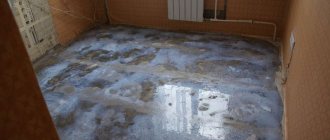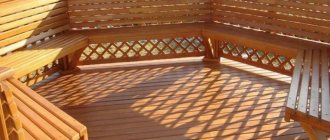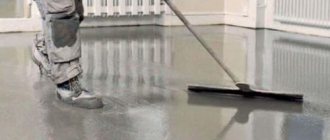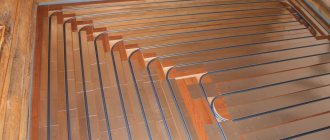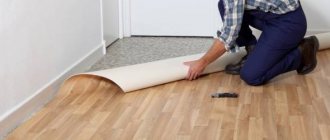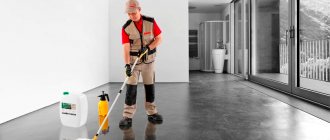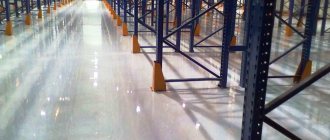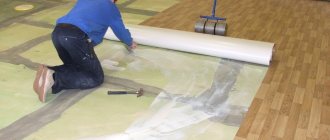Beton-House.com
Website about concrete: construction, characteristics, design. We combine the experience of professionals and private craftsmen in one place
Ready base
Concrete floors are the best base option for any facility: be it residential sector, industrial enterprises, public spaces, supermarkets or warehouses. Properly constructed, they will serve faithfully for decades. The final coating of the concrete floor is selected taking into account the conditions of use of the room: climatic factors, the load that will be placed on the surface.
- Floor construction
- Linoleum
- Porcelain tiles
Concrete floor: pros and cons
This coating has its advantages and disadvantages.
On the one hand, it is characterized by:
- strength;
- practicality;
- durability;
- environmental friendliness.
On the other side:
- such a floor is dusty (the top layer is subject to destruction, mechanical and chemical influences lead to the formation of cement dust over time);
- has poor sound insulation and unattractive appearance;
- The material in question is cold;
- it absorbs moisture because it is a hygroscopic material. This can lead to the formation of fungus and mold, and, over time, to the appearance of cracks.
Regardless of what coating will be used, the surface must be sanded (if this has not been done previously) and vacuumed. This way we will remove the weak top layer.
Grinding the concrete base
Let's consider what coatings are used for the floors in question:
Differences in constituent components
The mixtures are packaged in bags and can be cement or gypsum. Cement leveler is used in all types of premises, regardless of the degree of humidity, although it requires more time to harden. Perfect for screeds 20-50 mm.
Along with the varieties discussed, you can find mixtures with other types of components on sale:
- polyurethane, characterized by greater ductility, resistance to damage and cracking, and therefore used for finishing;
- cement-polyurethane - guarantee a more durable and wear-resistant structure;
- methyl methacrylate - harden quickly, very durable and moisture resistant;
- epoxy - allow you to create a durable and smooth surface, also useful for finishing with visual effects.
Coating options
Depending on the purpose of the room and taste preferences, there are different types of treatments and materials for flooring.
The use of concrete coating products is regulated by GOST 31384-2008, as well as recommendations for the construction of floors to SNiP 3.04.01-87 “INSULATING AND FINISHING COATINGS”, SNiP 2.03.13-88 “FLOORS”
Applying primer
Primer is the easiest way to control dust build-up, harden and protect the top layer, and make the floor more attractive. The compositions can be used as the sole coating of the base.
The following types of primers can be used as a primer:
- Epoxy. They have good waterproofing properties. The epoxy coating is resistant to detergents. Drying time is an hour.
- Polyurethane. Penetrate deeply into pores and have good adhesion to concrete. Drying time - 12 hours.
- Acrylic. The most budget option. Dries within 4 hours.
Surface after applying primer
Painting the concrete base
Paint is an excellent coating for concrete floors, for which there are no increased requirements for noise and heat insulation:
Important! For application, paint should be used that has a composition similar to the applied primer.
- Epoxy paint . It is resistant to aggressive environments, durable, and the painted coating looks good.
- Polyurethane enamel . Forms a perfectly smooth surface, is a well-covering, environmentally friendly coating.
- Acrylic enamel. Has high moisture resistance.
Painting: work process
Ready-made dry mixes
Since progress does not stand still, manufacturers of building materials have switched to the production of ready-made mixtures for leveling floors. In this composition, all proportions are obviously observed, which will create a surface of higher quality than with manual mixing. It is also worth noting that additives are added to the dry mixture, which provide improved characteristics for the screed.
The similarity with preparing the solution yourself is that you need to add the optimal amount of water to the mixture. The powder packaging always contains instructions indicating the volume of water required to achieve a high-quality base.
A dry mixture screed takes approximately 72 hours to dry. This period directly depends on the thickness of the screed being poured, but in any case, such a layer must dry for at least a day. The likelihood of subsidence of such a screed is minimal.
Self-leveling floors
A very popular wear-resistant coating, characterized by a stylish appearance, durability and hygiene.
It has its drawbacks:
- high cost;
- non-ecological (but it practically does not manifest itself in any way, since there will be no harmful emissions);
- excessive smoothness (you should be careful with this type of flooring in areas where elderly people and small children are present).
The photo shows what self-leveling floors can look like if you use 3D design.
Depending on the coating requirements, you can select a composition with the desired characteristics.There are self-leveling floors:
- Polyurethane . Due to the inclusion of plasticizers, they have good sound absorption. Available in glossy and matte finishes. Resistant to aggressive environments. Good resistance to impacts. Best suited for residential use.
- Epoxy . Transparent, which is used in decoration. They are resistant to abrasion, but have low strength.
- Methyl methacrylate . They dry quickly and have good strength characteristics. But they can release toxic compounds, so they should not be used in crowded places.
- Polymer-cement . They have waterproof and antistatic properties.
- Acrylic . The least durable of all options.
Floor construction
You will need the following tools:
Let's look at the step-by-step process of covering a surface with a self-leveling mixture:
| To compensate for possible expansion and protect the coating from cracks, we glue the perimeter of the room with damper tape. |
| Pour the solution prepared according to the manufacturer’s instructions onto the primed concrete base. Pour out a little, each time about 2 sq.m. |
| Level it with a spatula. Coating thickness 1.5...8 mm. After leveling, pour in the next portion. You should work without interruption. |
| Using a needle roller, remove air bubbles. We perform this procedure after each portion of the solution. |
| We control the correct filling using a manual or laser level. |
| To protect the floor and give it shine, we coat the surface with polymer varnish. This should be done after the surface has dried. |
To create a 3D effect, a film with a printed image is placed under the finishing layer. Concrete floors coated with a leveling mixture are an excellent option for home and public buildings. If necessary, you can install thermal insulation under it or install a “warm floor” system.
General information about levelers
So what is a leveler? The bulk of leveling agents in stores are sold in the form of a dry bulk mixture, packaged in bags of various sizes. Self-leveling mixtures are produced on cement, polymer-cement, gypsum and polymer-gypsum bases. Pure water is used as a solvent for mixtures.
There are two types of leveling mixtures:
- levelers for rough leveling;
- levelers for final leveling.
The first, rough layer may be the only one, but more often it is covered with a second layer, which is the finishing layer, it allows you to make the leveled surface of the floor smooth.
Basic levelers with coarse fraction components allow you to quickly level the surface relative to pre-prepared markings. The final leveling smooths out the roughness from the coarse-grained components of the previous layer, so a leveler thickness of several millimeters will be sufficient.
Beginning of work
Floor repairs are carried out after all work on the ceiling, if any, has been completed.
While working, make sure that you and your assistants follow basic safety precautions.
- To avoid short circuits and other accidents, de-energize the wiring in the room.
- All work should be carried out wearing safety glasses, and it is also recommended to wear a hat.
- When using cement-based mixtures, remember that it reacts alkaline with water.
- Use rubber gloves when working with such mixtures.
- A respirator will prevent harmful dust from entering your respiratory tract. Use a serviceable tool and only for its intended purpose.
- Doors and windows in the room must be tightly closed.
- About two weeks should pass from the time the foundation is prepared.
- The recommended indoor temperature is between +10 - +25 oC, and the relative humidity is less than 95%. Avoid drafts in the first 1-2 days after pouring.
- You should familiarize yourself with the recommendations of the mixture manufacturer to obtain the maximum quality of the work performed.
Parquet
This material has always been popular. When the question arises of how to cover a concrete floor in an apartment, this option often turns out to be the most advantageous.
Laying parquet:
- Glue sheets of moisture-resistant plywood onto the primed base. It is imperative to provide deformation distances of 1.5-2 mm between the sheets.
- Attach the plywood using dowels.
- Lay out the soundproofing underlay.
- Attach the parquet using a tongue-and-groove joint, glue, and in some cases, nails.
Parquet laying
To correctly form the drawing, it is best to first do this on paper. The planks should be placed in such a way that the cut parts are located at the edges of the room.
The laid parquet should be sanded, and if defects appear, they should be repaired with putty. After this, apply several layers of varnish. Each layer is applied after the previous one has completely dried.
Parquet floor
Laying parquet is a troublesome task, but the result should please you.
Error 7: leaving drafts and not protecting the screed from direct sunlight
Once the floor is finished pouring, you can relax and wait quietly. This position was voiced by 36% of buyers.
But this is a mistaken opinion. Even before starting work, you must make sure that there are no drafts in the room, that the windows are closed, and that direct sunlight does not fall on the floor surface. Otherwise, this will lead to premature drying of the mixture and the appearance of shrinkage cracks, as well as peeling of the screed from the base.
Incorrect use of heat guns leads to the same result - they should be aimed at the ceiling and not at the floor surface
It is very important not to overheat the room. Temperature +25°C is enough
Right on the sore spot, I recently did some repairs, well, not me, but the repairmen, if you can call them that. In general, the floor, although it is laid with laminate, is just like after a “bombing”, or like our roads, everything creaks and sags.
And this is an interesting thing with rubber crumbs, and it can be used on playgrounds. We need to take it into account.
I know people who have laid laminate and even linoleum on warm water floors. It's clear what this could lead to. And I know people who laid laminate flooring in the gym, and the first dumbbell that fell made a hole in the floor.
The best floor screed
In a new room or one requiring major renovation, as a rule, you have to decide the issue of arranging floors and choosing a screed.
A screed is an intermediate layer between the base of the floor and the floor covering; it compensates for unevenness, provides heat and sound insulation, and masks utility lines.
The screed is made from various building mixtures, carefully leveling and smoothing them
It is important that there are no voids or cracks in the screed; the service life of the floor depends on this
Roll coverings
Linoleum
This material has excellent characteristics, and it also has an affordable price.
Laying flooring on a concrete floor with your own hands is not a very complicated process:
- Before installation, the roll must be brought into the room and laid out on the floor for 12 hours.
- After this, cut it according to the size of the room, making allowances of 10 cm in case it shrinks.
- Apply glue to the inside of the covering and carefully glue the linoleum, smoothing the surface.
- When laying several strips of material, they are glued together using special glue.
- In small rooms it is permissible not to glue linoleum. It is enough to fix it with skirting boards.
Floor with laid linoleum.
Carpet
Carpet installation is simple. If you put an elastic backing under the carpet, you should first glue it, and then the carpet.
When laying the covering in a large room, even without a backing, you need to glue it to the base. In small rooms you can lay carpet without using glue, simply pressing it with a baseboard.
Floor with carpet
Self-leveling compounds
Each type of self-leveling mixture has its own application conditions and rules.
They can be divided into three main categories, each of which will differ in its own application technology and perform its own tasks:
When choosing a self-leveling mixture, you need to immediately pay attention not only to the method and type of application, but also to the constituent elements. There are two types of self-leveling screed mixtures:
Cement mixtures can be used anywhere, but the layer thickness should not exceed 50 mm. Gypsum mixtures can eliminate very serious unevenness and can be applied in a layer of more than 100 mm. However, they will require a low level of humidity in the room during work and good waterproofing.
Alignment
Before starting work, you need to select a screed in accordance with the type and condition of the surface. It is not recommended to use such mixtures on wooden bases and floors. The only exception may be materials intended only for such a base.
In any case, careful preparatory work must be carried out in order to ensure the best adhesion to the surface. Depending on the capabilities and qualities of each screed composition, leveling the floor can take from several days to three weeks.
Some manufacturers produce quick-drying mixtures on which the coating is applied on the same day, a few hours after application. However, their advantages are an order of magnitude lower than those of conventional ties, and the price is higher. These mixtures can be successfully used to correct small irregularities in a short time, but they are not suitable for major reconstructions.
In order to start making a base for a decorative coating, you need certain skills and dexterity. Since the time for working with the finished solution is limited, assistants will be required. Alignment must be done in one go, because the presence of joints is unacceptable.
The choice of the number and type of tool depends on the initial condition of the surface and the complexity of the work. For final leveling you will need a tool: a drill and a mixer attachment or a concrete mixer, containers for creating the mixture, a spatula for applying the mixture, a needle roller to remove bubbles, a metal brush.
After completing the screed, you need to give it time to dry completely. Depending on the type of material, external conditions and layer thickness, this can take up to several weeks. Only after this can you begin to lay the topcoat.
Failure to comply with this rule may lead to the appearance of mold, damage to materials and other negative aspects. After the screed is applied, you need to try not to cool or overheat the surface, and also not to let it dry out. It should be lightly sprayed with water several times a day: this will prevent cracks from appearing. After final drying, the floors are cleaned of roughness using a metal brush.
Laminate
Reliable and affordable material. Laminate is an excellent covering. A substrate should be laid on the concrete base (usually foamed polystyrene 3 mm thick is used). The rows of backing can be secured together with tape. The panels can be laid longitudinally, transversely or diagonally.
Important! The laminate should extend 1 cm from the wall (damper indentation).
The dies are attached to each other using locking connections. The ridge of the first row of panels should be cut off (on the side closest to the wall). Assembly is carried out in rows. If necessary, parts of the panels are sawed off with a hacksaw or jigsaw.
Laying laminate
How thick should the leveling layer be?
The base may have significant differences in height. Then the best option would be to use a composition whose layer thickness exceeds 5 cm. Such products that form a coating 4-5 cm thick are called self-leveling mixtures. Thin-layer compounds are used for finishing. The applied layer is up to 1 mm.
How long will the composition take to dry?
Drying time is the period (hours, days) required for the self-leveling floor to harden. That is, a person will already be able to walk freely on the surface.
However, it is still too early to start finishing work. Laminate or tiles can only be laid in a week, maximum in a month.
The gypsum-containing floor hardens quickly (within 2-4 hours). The polyurethane composition will take up to 20 hours to harden. And cement mixtures and epoxy compounds are left alone for a day or even two days.
Many buyers are more suitable for inexpensive formulations. On the packaging you can find information about material consumption: the number of kilograms per 1 square meter, layer thickness - 1 mm. Moreover, the highest consumption is observed for cement mixtures.
Ceramic tile
Tiles are often chosen for installation. Based on the purpose of the premises or simply at the request of the owner. This material is characterized by low abrasion and low water absorption coefficient.
Let's look at the stages of its installation:
- Using a notched trowel, apply a layer of diluted glue to the prepared surface.
- The tiles are embedded in the glue. To improve the fit, tap it with a mallet.
- The following tiles are laid side by side, with plastic crosses installed between them to form a gap. Periodically check the horizontal position with a level.
- If necessary, cut parts of the tiles using a tile cutter.
- After an hour, the crosses can be removed.
- Every other day, the seams between the tiles should be grouted.
- Use a damp sponge to remove excess grout and stains.
Laying tiles
Porcelain tiles
Porcelain stoneware is actively used to cover floors in homes, supermarkets, and public spaces. It is more durable than ceramic tiles, wear-resistant, durable.
Its installation is similar to that of ceramic tiles, with the only difference being that a different adhesive is selected and cutting of the slabs is a much more labor-intensive process due to the size of the material.
Laying porcelain tiles
Choosing a floor covering is extremely important and not easy. It needs to be taken responsibly, having analyzed all the pros and cons. Properly selected and installed coated concrete floors will serve you faithfully for many years.
Why is alignment necessary?
Nowadays people often do indoor renovations on their own - why overpay when you can find a lot of tutorials on how to carry out the work and just follow step-by-step instructions? But sometimes the technology can be violated by novice craftsmen - somewhere they neglected to add a component to the building composition, and somewhere they skipped a whole step, considering it unnecessary. The result can be sad - for example, when pouring a new screed, you end up with an uneven base, on which you should never lay tiles or laminate flooring, as this will cause them to deform very quickly. And the result is wasted money and time.
Cracks in floor tiles
Attention! To prevent this from happening, it is important to always strictly follow the installation instructions, including those for arranging the floor. This will save both money and time, and as a result, the finish coating will delight its owner for many years and will not require replacement for a long time.
Also, wooden floors may require additional leveling of the base if there are cracks and gaps between the floorboards, but in general the floor is quite strong, does not creak and does not require disassembly and repair.
How to Measure the Curvature of a Wooden Floor
Finishing leveling is also used when installing the floor on an old but reliable screed. It’s just that over time, the rough base may become rough, cracks will appear on it, and finishing leveling will help get rid of these irregularities.
Old screed after sanding
The most popular manufacturers
There are such popular compositions:
Vetonit mixture
Knauf mixture
"Knauf". The presented solution is used quite often. Its characteristics ensure the demand for the material. Very popular on the market is the Knauf Baden solution, which contains high-quality gypsum. In addition, quartz sand can be added to the product for better adhesion to the base. Modified additives make the Knauf composition easy to use and very high quality.
Ceresit mixture
"Ceresite". This self-leveling mixture can be used on concrete and sandy substrates. After pouring this solution, you can use wood, tiles, linoleum, and even carpet as flooring.
I would like to say separately about the self-leveling Hercules floor. This mixture is universal, dries quickly, and has positive reviews. For example, the solution spreads well and provides a perfectly flat surface. The only drawback is that it needs to be made more liquid than what is written in the manufacturer's instructions.

